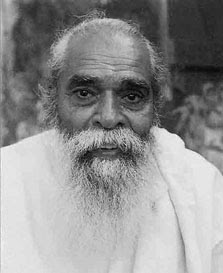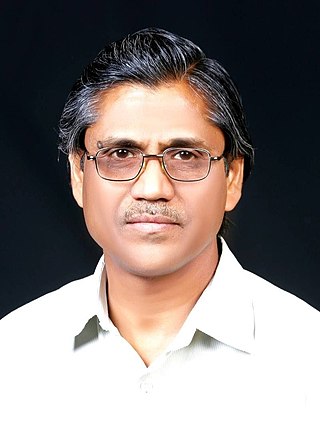Related Research Articles

Sarathi is an epithet of the Hindu deity Krishna used in the epic Mahabharata. It is also a common personal name in South India.

The Bhagavad-Gītā As It Is is a translation and commentary of the Bhagavad Gita by A. C. Bhaktivedanta Swami Prabhupada, founder of the International Society for Krishna Consciousness (ISKCON), commonly known as the Hare Krishna movement. This translation of Bhagavad Gita emphasizes a path of devotion toward the personal God, Krishna. It was first published in 1968 in English by Macmillan Publishers, and is now available in nearly sixty languages. It is primarily promoted and distributed by members of ISKCON.

Ganapathi Venkataramana Iyer was an Indian film director and actor. He was nicknamed "Kannada Bheeshma". His film Adi Shankaracharya (1983) won four National Film Award, including Best Film, Best Screenplay, Best Cinematography and Best Audiography. His film Swami Vivekananda (1998) was nominated in the Best Film category at the Bogotá Film Festival, for which Mithun Chakraborty won the national award for Best Supporting Actor.

Gita Mahotsav,Gita Jayanti, also known as Mokshada Ekadashi or Matsya Dvadashi is a Hindu observance that marks the day the Bhagavad Gita dialogue occurred between Arjuna and Krishna on the battlefield of Kurukshetra. It is celebrated on Shukla Ekadashi, the 11th day of the waxing moon of the lunar month Margashirsha (December–January) of the Hindu calendar.

Jyotisar, on the bank of Jyotisar Sarovar wetland, is a Hindu pilgrimage site in the city of Kurukshetra in Haryana state of India. According to Hindu tradition, Krishna delivered the sermon of Bhagavad Gita - the doctrine of Karma and Dharma to his wavering friend Arjuna to guide him to resolve his ethical dilemma and revealed his vishvarupa to him.

Tikkavarapu Subbarami Reddy is an Indian industrialist, politician, film producer, and a philanthropist. In 1993 he produced the Sanskrit film Bhagavad Gita, which garnered the National Film Award for Best Feature Film at the 40th National Film Awards.

The Bhagavad Gita, often referred to as the Gita, is a 700-verse Hindu scripture, which is part of the epic Mahabharata. It forms the chapters 23–40 of book 6 of the Mahabharata called the Bhishma Parva. The work is dated to the second half of the first millennium BCE.

The Gītā Dhyānam, also called the Gītā Dhyāna or the Dhyāna Ślokas associated with the Gītā, is a 9-verse Sanskrit poem that has often been attached to the Bhagavad Gita, one of the most important scriptures of Hinduism. In English, its title can be translated literally as "meditation on the Gita," and it is also sometimes called the Invocation to the Gita.
The 40th National Film Awards, presented by Directorate of Film Festivals, the organisation set up by Ministry of Information and Broadcasting, India to felicitate the best of Indian Cinema released in the year 1992. Ceremony took place in 1993.
The Bhagavad Gita a Hindu scripture in Sanskrit that is part of the Mahabharata.
P. Krishnamoorthy was an Indian film art director, production designer and costume designer who worked predominantly in the South Indian cinema. As of 2015, he had worked in over 55 films in Kannada, Tamil, Telugu, Sanskrit, Malayalam and English, and won five National Film Awards—three for Best Art Direction and two for Best Costume Design. In addition, he was the recipient of five Kerala State Film Awards and four Tamil Nadu State Film Awards. The five-time National Award winner died in Chennai on 13 December 2020, due to age related ailments.

Sanskrit cinema is a part of Indian cinema with only 15 films made since 1983, and there is no separate industry for Sanskrit films.

God Talks with Arjuna: The Bhagavad Gita is a posthumously published non-fiction book by the Indian yogi and guru Paramahansa Yogananda (1893–1952). It is a two-volume work containing an English translation and commentary of the Bhagavad Gita. It explicates the Bhagavad Gita's psychological, spiritual, and metaphysical elements. It was originally published in 1995 in Los Angeles by the Self Realization Fellowship, and later published in other countries and languages. The book is significant in that unlike other explications of the Bhagavad Gita, which focused on karma yoga, jnana yoga, and bhakti yoga in relation to the Gita, Yogananda's work stresses the training of one's mind, or raja yoga. The full title of the two-volume work is God Talks with Arjuna: The Bhagavad Gita – Royal Science of God Realization – The Immortal Dialogue between Soul and Spirit – A New Translation and Commentary.

Sushrut Badhe is an Indian author, researcher on Sanskrit scripture and manufacturer of Ayurvedic products. He has rewritten the Sanskrit scriptures Bhagavad Gita and three Upanishads, Isha, Kena and Mandukya in rhymed English.

Dantu Muralikrishna is an Indian scientist, writer and singer based in Bhopal, Madhya Pradesh, India.

The Arjuna Vishada-yoga is the first of the eighteen chapters of the Bhagavad Gita. The chapter has a total of 47 shlokas. The chapter is the 23rd chapter of Bhishma Parva, the sixth book of the Mahabharata.

The Samkhya Yoga is the second of the eighteen chapters of the Bhagavad Gita. The chapter has a total of 72 shlokas. The chapter is the 26th chapter of Bhishma Parva, the sixth episode of the Mahabharata.

The Jnana Karma Sanyasa Yoga, also spelled as the Gnana Karma Sanyasa Yoga, is the fourth of the eighteen chapters of the Bhagavad Gita. The chapter has a total of 42 shlokas (verses). The chapter is the 28th chapter of the Bhishma Parva, the sixth book of the Mahabharata.

The Jnana-Vijnana Yoga is the seventh of the eighteen chapters of the Bhagavad Gita. The chapter has a total of thirty shlokas. it is the 29th chapter of Bhishma Parva, the sixth book of the Mahabharata.

The Akshara Brahma Yoga is the eighth of the eighteen chapters of the Bhagavad Gita. The chapter has a total of twenty-eight shlokas. It is the 30th chapter of Bhishma Parva, the sixth book of the Mahabharata.
References
- ↑ "Bhagavad Gita summary". sites.google.com. Retrieved 22 August 2020.
- ↑ "Directorate of Film Festival" (PDF). Archived from the original (PDF) on 3 April 2014. Retrieved 22 September 2014.
- ↑ "Bhagvad Gita (film) G V Iyer". IMDb. Retrieved 9 March 2012.
- ↑ "40th National Film Awards". India International Film Festival. Archived from the original on 2 June 2016. Retrieved 2 March 2012.
- ↑ "40th National Film Awards (PDF)" (PDF). Directorate of Film Festivals . Retrieved 2 March 2012.